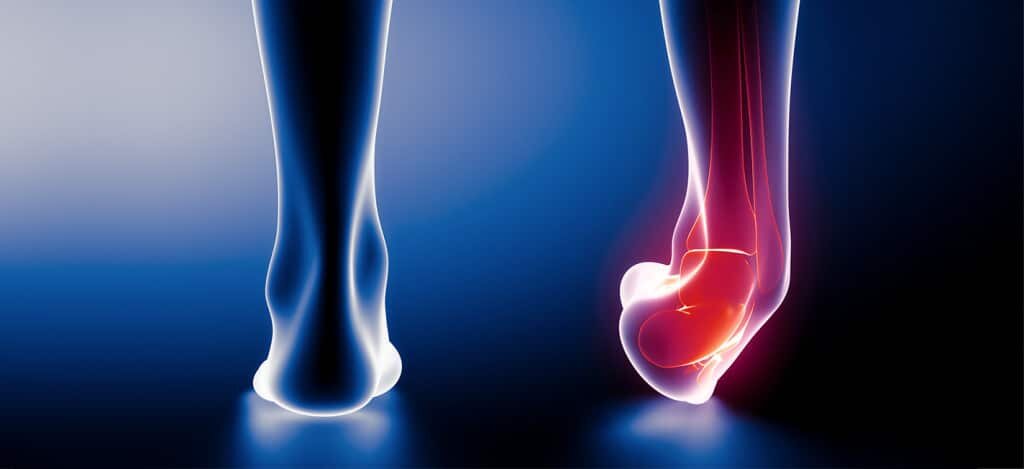Ankle Injuries and Conditions
Your ankle is a hinge joint that allows motion up and down, and from side to side. Your foot and ankle have several ligaments. These are strong band-like structures that keep the bones in your ankle and feet tightly connected. On the outer side of your foot, you have several ligaments. These include the anterior talofibular ligament (ATFL) and the calcaneofibular ligament (CFL). These help keep your ankle and foot steady when you walk. When sprains occur, the ligaments stretch beyond normal capacity and tear. Ankle sprains range from mild to severe and in most cases do not require surgery. Sprains of the midfoot — called a Lisfranc injury — can often be treated successfully with non-surgical techniques as well. But in more serious cases, ligament repair surgery may be recommended.
Ankle strains, fractures, and other chronic conditions (tendinitis) can also occur and are treated at Aptiva Health. Muscle and tendon strains are more common in the legs and lower back. In the ankle, there are two tendons that are often strained. These are the peroneal tendons, and they stabilize and protect the ankle. They can become inflamed as a result of overuse or trauma. Acute tendon tears result from a sudden trauma or force. The inflammation of a tendon is called tendinitis. Microscopic tendon tears that accumulate over time, because of being repeatedly over stretched, and don’t heal properly lead to a condition called tendinosis.
At Aptiva Health, we offer immediate appointments for ankle injuries and conditions to evaluate, diagnose, and make the appropriate referral for additional treatment based upon your specific ankle injury or condition. We treat these conditions in our General Medicine, Orthopedics, Sports Medicine, and Physical Therapy departments.
Symptoms
The symptoms of a sprain and of a fracture are very similar. In fact, fractures can sometimes be mistaken for sprains. That's why it's important to have an ankle injury evaluated by a specialist at Aptiva Health as soon as possible. The signs include:
Pain, often sudden and severe
Swelling
Bruising
Inability to walk or bear weight on the injured joint
With a sprain, the ankle may also be stiff. With a fracture the area will be tender to the touch, and the ankle may also look deformed or out of place. If the sprain is mild, the swelling and pain may be slight. But with a severe sprain, there is much swelling and the pain is typically intense.
Tendinitis and acute tears of the peroneal tendon result in both pain and swelling. In addition, the ankle area will feel warm to the touch with tendinitis. With an acute tear, there will be a weakness or instability of the foot and ankle.
Tendinosis may take years to develop. Symptoms include:
Sporadic pain on the outside of the ankle
Weakness or instability in the ankle
An increase in the height of the foot's arch
With the subluxation you will notice ankle instability or weakness. You also may notice sporadic pain behind the outside ankle bone and a "snapping" feeling around the ankle bone.
Diagnosis and Treatment
At Aptiva Health, our sports medicine and orthopedic team use musculoskeletal ultrasound, an advanced imaging technology, to accurately diagnose ankle injuries and conditions in addition to our high-field open MRI. The ultrasound is typically used during a thorough physical examination of the ankle.
A musculoskeletal ultrasound uses sound waves to create images of soft tissues in the foot and ankle such as ligaments, tendons, muscles and nerves. These images are extremely detailed and can reveal the extent of damage and exact cause of all types of foot and ankle ligament conditions.
Your physician will determine the severity of your sprain by assigning a "grade" to it:
Grade 1: Minimal stretching and tiny microscopic tears in the fibers of the ligaments accompanied by mild swelling, redness and pain.
Grade 2: Partial to moderate tear of the ligaments accompanied by swelling, redness and pain.
Grade 3: Completely torn ligament accompanied by swelling, redness, pain and total ankle instability
Dependent upon the severity of the ankle injury or sprain, your doctor will determine what treatment plan will work best. For less severe sprains and ankle injuries, the following conservative treatments may be recommended:
Activity modification
R.I.C.E. (rest, ice, compression and elevation)
Anti-inflammatory medication
Compression: bracing, casting, wraps, or kinesiotaping
For more severe ankle sprains or injuries, or for chronic ankle conditions, surgery may be indicated. You may be a good candidate for ligament surgery if you:
Experience chronic pain in your foot and ankle
Suffer from repeated ankle sprains
Have an ankle that gives way when walking, running or exercising
If you have severe ligament damage caused by an ankle sprain, overuse or injury, your doctor will likely recommend ankle ligament surgery.
fractures
Fractures can be treated either surgically or non-surgically. Your specialist may treat the fracture without surgery by immobilizing the ankle (with casting or bracing) if only one bone is broken, and if the bones are not out of place (non-displaced) and the ankle is stable.
If the ankle is unstable, the fracture will be treated surgically. Often, the ankle is made stable by using a metal plate and screws to hold the bones in place. Following the surgery, the ankle is protected with a splint until the swelling goes down and then with a cast.








